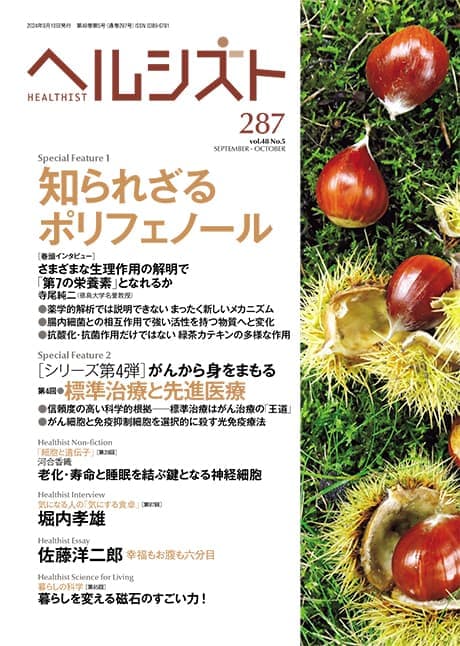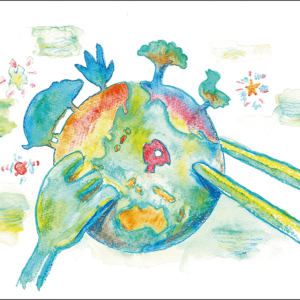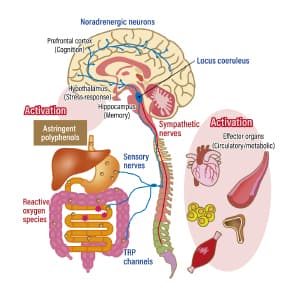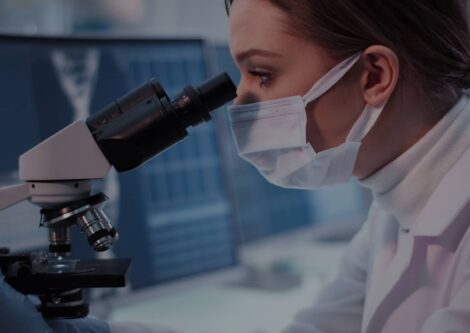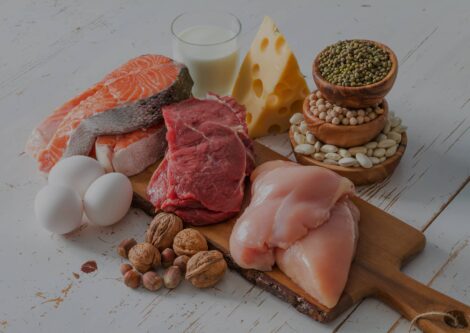Polyphenols are chemical substances that plants produce in order to survive in their surrounding environment, from which they cannot move. Although polyphenols are known to have beneficial physiological effects for humans, with antioxidant and anti-inflammatory properties, their mechanisms of action are, for the most part, a mystery. Their most reliably established property is their protective effect on blood vessels. Scientists say polyphenols act to prevent the onset of cardiovascular disease by curbing arteriosclerosis. If efforts to shed light on their effects progress, polyphenols might one day be classed as the “seventh nutrient,” alongside protein, fat, carbohydrates (also known as the three major nutrients), vitamins, minerals, and dietary fiber.
Special Feature 1 – The Mysteries of Polyphenols Could polyphenols be the “seventh nutrient” that explains all kinds of physiological effects?
composition by Yuko Watanabe
Polyphenols exist throughout the epidermis of the leaves of most plants and the flesh of their fruit, among others. The functions of polyphenols in regulating the human body are attracting attention. Whereas primary metabolites are involved in plants’ direct biological processes, such as photosynthesis and protein production, secondary metabolites are compounds that plants produce in order to appropriately survive in the environment in which they grow —— as, unlike animals, they cannot move freely —— and also to maintain that environment. Polyphenols are secondary metabolites.
The diverse physiological effects of polyphenols
In terms of molecular structure, polyphenols are a class of compounds that share a common skeleton consisting of one or more aromatic hydrocarbons (benzene rings) and one or more reducible phenolic hydroxyl groups, which are attached to each other in complex ways. There are said to be at least 8,000 kinds of polyphenols; the term polyphenol itself is derived from the fact that they consist of many (indicated by the Greek suffix “poly-”) phenolic hydroxyl groups. Plants produce a large, diverse array of polyphenols tailored to their habitat, according to their species, and there are thought to be as many different varieties of polyphenols as there are plants.
Looking back, there are seven main physiological effects of plant polyphenols that have made me aware of the power of plants.
- (1) Protective effect against ultraviolet rays. While sunlight is needed for photosynthesis, ultraviolet rays are harmful to plants, so they produce polyphenols near the epidermis as an ultraviolet absorber.
- (2) Antimicrobial effect. As there are various pathogenic microbes that can also hinder plant growth, plants produce a large quantity of polyphenols to act as antimicrobial constituents in the infected portion, thereby defending against infection. For instance, the sakuranetin that prevents the spread of rice blast infection is a type of polyphenol.
- (3) Preventive effect against intrusion by other plants. Also known as allelopathy, this effect prevents the germination and growth of other plants. Polyphenols eluted from fallen leaves and from roots inhibit the germination of other seeds to protect the plant’s own territory.
- (4) Repellent effect against consumption by animals. To repel omnivorous and herbivorous animals, polyphenols act as bitter and astringent components, and also deactivate digestive enzymes, thereby serving as a message that the plant will not taste good when eaten. In days gone by, humans thought that the harsh taste of polyphenols was responsible for stomach upsets, and that it was necessary to prepare the plants (for example, by steeping them in vinegared water for a while) to remove the harsh components.
- (5) Attractive effect for pollinating insects. The beautiful reds, purples, and other colors of flowers are a sign designed to attract insects that will pollinate the plants. Principally responsible for flower color are a class of polyphenol called anthocyanins, which are plant pigments. These anthocyanins form various colors, depending on differences in their molecular structure and hydrogen ion concentration index (pH).
- (6) Attractive effect for seed-dispersing creatures. One method plants use to disperse their seeds in order to ensure they produce offspring is to have birds eat their fruit. The seeds are protected by their seed coat and are excreted undigested along with the bird’s feces, which helps to expand the range within which the seeds germinate. Anthocyanins also produce the color of fruit, which serves as a sign that the fruit is ripe enough to be tasty.
- (7) Symbiotic effect for microorganisms. A member of the legume family, the soybean is an example of a plant that grows even in soil without a rich supply of nutrients. Rhizobia —— a group of bacteria that live in soil —— have built a symbiotic relationship with leguminous plants by causing the formation of nodules on their roots, and then gathering nitrogen from the air, which they supply to plant cells as a nutrient. Aiding this process are polyphenols called luteolin and hesperetin, which are present in the roots of leguminous plants and are believed to activate the nodule-forming gene in rhizobia.
Thus, plants make use of the secondary metabolites known as polyphenols in a variety of forms in order to survive and broaden the range within which they are found.
Foods containing polyphenols include such plant-derived items as vegetables, fruit, tea, coffee, chocolate, and red wine (Figure 1). Broadly speaking, polyphenols can be divided into polymeric tannins (hydrolysable tannins and condensed tannins) and monomeric polyphenols (including phenolic carboxylic acid derivatives, flavonoids, lignans, and stilbene derivatives) (Table). Most polyphenols present in the plant world are flavonoid compounds, which are further classified into such groups as flavones and flavonols, which are found in large quantities in vegetables; flavanones, in which citrus fruits are rich; anthocyanidins, which are found in large quantities in various fruit; flavan-3-ols (catechins), in which tea and cacao are rich; and isoflavones, which are found in large quantities in soybeans.
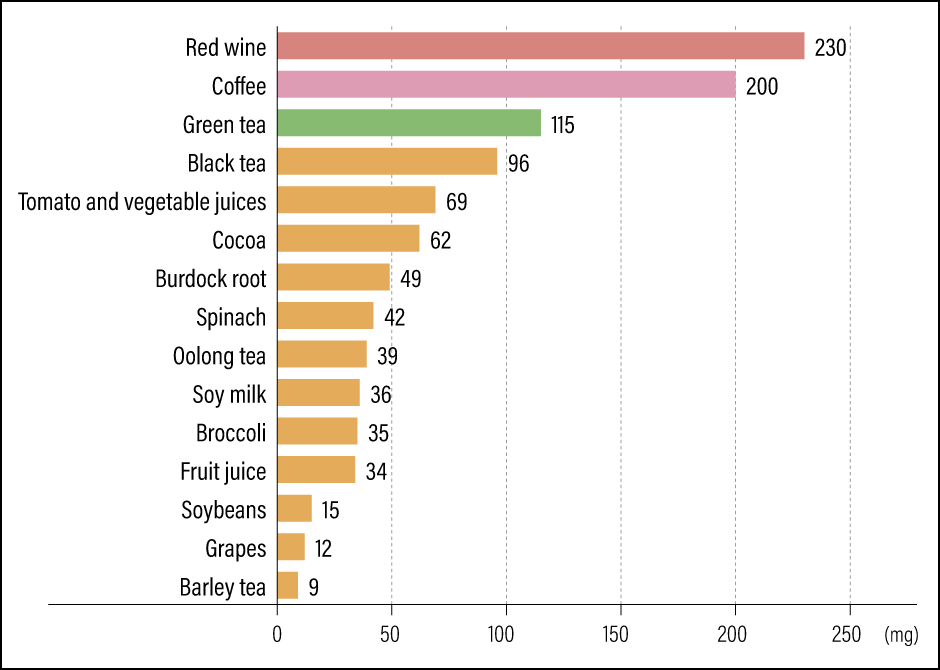 Fukushima Y, et al. J Agric Food Chem, 57: 1253–1259, 2009.
Fukushima Y, et al. J Agric Food Chem, 57: 1253–1259, 2009.
Figure 1. Polyphenol content per 100 g of major foodsPlant-derived foods are rich in polyphenols. Drinks such as coffee and green tea are believed to be the main sources of polyphenols for Japanese people. It is hoped that recommended intakes will be indicated as research progresses.
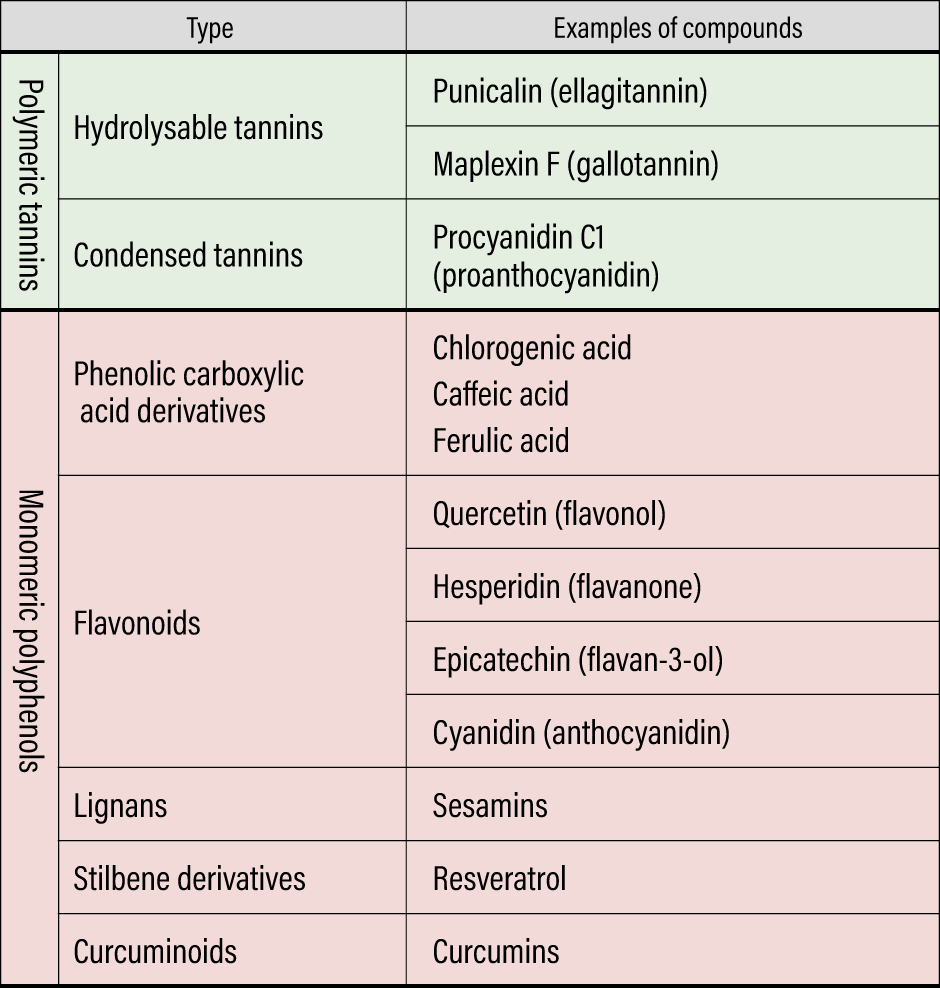
Table. Main types and groups of polyphenolsPolyphenols are components found in flowers, leaves, bark, and other parts of plants, and are classified on the basis of their chemical structure. There are said to be at least 8,000 varieties of these compounds, which have multiple aromatic hydrocarbons and reducible phenolic hydroxyl groups.
Polyphenols began to become the focus of attention in 1936, when Albert Szent-Györgyi —— who was awarded the Nobel Prize for the discovery of vitamin C —— et al published the first report on the physiological functions of polyphenols. They showed that a flavonoid found in citrus fruits protected human blood vessels by elevating low capillary resistance and curbing vascular hyperpermeability; the authors named the substance vitamin P. Today, the existence of vitamin P is denied, because there are no vitamin deficiencies that can be confirmed as relating to polyphenols.
Since 1990 or thereabouts, one major topic of discussion concerning the relationship between fat intake and rates of mortality due to coronary heart disease has been the French paradox. Specifically, this concerns the phenomenon in which, even though French people have high cholesterol and saturated fatty acid intake, their rates of mortality from coronary heart disease are low, which ostensibly turns the causal relationship on its head. As red wine intake in France is high, it was hypothesized that the polyphenols in red wine might have the effect of minimizing arteriosclerosis, and the resultant global red wine boom remains fresh in one’s memory even now.
Producing indirect effects by working on the gastrointestinal tract
Research into polyphenols progressed gradually, but scientific attention began to focus on them when a Dutch research team published a full-scale epidemiological study in 1993. The study reported an inverse relationship between flavonoid intake and rates of mortality due to coronary heart disease in Dutch adults. Tea, onions, and apples were cited in the study as the most important sources of flavonoids. The findings from this research triggered a variety of epidemiological studies and small-scale human intervention trials concerning effects in maintaining the blood vessels, which led to further attention focusing on the physiological effects of polyphenols.
As one of their effects in maintaining the blood vessels, polyphenols were thought to play a part in combating oxidative stress. The reducible phenolic hydroxyl groups that form part of the basic structural skeleton of polyphenols are known to demonstrate direct antioxidant properties by trapping and eliminating the free radicals that cause aging and assorted diseases, including cancer and arteriosclerosis. Accordingly, scientists anticipated that polyphenols would have antioxidant properties.
However, the absorption of polyphenols into the body is of the utmost importance in understanding the physiological effects of polyphenols. This differs according to the type of polyphenol; polymeric tannins are hardly absorbed into the body at all, passing from the mouth to the stomach, small intestine, and large intestine before being excreted in feces. Monomeric polyphenols are partly absorbed in the small intestine, but the body basically does not recognize them as nutrients; instead, deeming them to be toxins, it subjects them to metabolic detoxification by the liver and they are ultimately excreted in urine.
We consume polyphenols on a daily basis in vegetables, fruit, and beverages such as coffee and tea, but while our intake of polyphenols is higher than that of carotene and vitamin E, their bioavailability is actually lower. In other words, looking at antioxidant effects, polyphenols swiftly undergo metabolic conversion, so their effective concentration in blood does not reach a high enough level for them to be able to demonstrate a direct effect in capturing free radicals. Consequently, scientists came to deny that polyphenols played a part as antioxidants by directly trapping and eliminating free radicals.
Looking at the physiological effects of polyphenol intake, at the cellular and laboratory animal level, studies have suggested that, in addition to antioxidant and anti-inflammatory effects, polyphenols could possibly prevent noncommunicable diseases such as lifestyle diseases via involvement in the intracellular information transmission system and the regulation of gene expression. Nevertheless, as the pharmacokinetics of polyphenols are thought to differ from one species to another, caution is required when seeking to apply the results of animal research to humans.
With regard to the aforementioned antioxidant effects of polyphenols, scientists moved away from the idea that polyphenol intake had a direct antioxidant effect on the body, and began to think that polyphenols exerted multifaceted indirect effects via the gastrointestinal tract. As such, research focused on the digestive tract has been progressing.
Reports on numerous epidemiological studies and intervention trials in humans have suggested that the physiological effects of polyphenol intake on humans include the prevention of cardiovascular disease, the prevention of metabolic syndrome (abnormalities in lipid metabolism, diabetes, high blood pressure, and visceral obesity), the prevention of locomotive syndrome (osteoporosis and sarcopenia (age-related muscular atrophy)), antiallergic action, and effects in maintaining cognitive function associated with the prevention of Parkinson’s disease and Alzheimer’s disease.
Of these, the physiological effect whose expression is regarded as the greatest certainty is the protective effect of polyphenols on blood vessels —— specifically, polyphenols’ effect in curbing arteriosclerosis and preventing the onset of cardiovascular disease. Indeed, this exact effect was suggested by a report on the results of a Danish cohort study of a dietary survey relating to flavonoid intake that was published in 2019 (Bondonno NP, et al. Nat Commun, 10: 3651, 2019). In this prospective study that tracked results from root causes, scientists conducted a dietary survey of 56,048 Danish adults aged between 50 and 65, and followed them up for a period of around 23 years.
The study found that flavonoid intake is inversely associated with all-cause, cardiovascular-, and cancer-related mortality. Among non-smokers, the inverse association was not found to increase further at intakes beyond 500 mg per day. In other words, the study showed that 500 mg is the limit of the inverse association between flavonoid intake and mortality rates. Among smokers, the inverse association was observed up to flavonoid intake levels of 1,000–2,000 mg, indicating the possibility that proactive consumption of foods with a high flavonoid content by smokers could lower their mortality rate.
Unraveling the mechanisms of action is essential
However, as this is an epidemiological study, it does not directly prove a relationship between smokers’ risk of disease and flavonoid consumption; a large-scale intervention trial in humans would be required to demonstrate this. A report on a study aimed at investigating this point attracted the attention of polyphenol researchers when it was published in 2022. This was the COcoa Supplement and Multivitamin Outcomes Study (COSMOS; Sesso HD, et al. Am J Clin Nutr, 115: 1490–1500, 2022), a large-scale intervention trial focused on cardiovascular disease and polyphenol intake, which was conducted in the U.S. among 21,442 people (12,666 women aged 65 and older, and 8,776 men aged 60 and older). In this randomized, double-blind, placebo-controlled comparative study, the test subjects took two capsules containing a cocoa extract every day (500 mg of cocoa-derived flavanols, including 80 mg of epicatechin) for three to four years, and were tracked for a total of five years. While the results did not show that taking the cocoa extract significantly reduced the incidence rate of cardiovascular disease, they did demonstrate that the supplement significantly reduced the mortality rate by as much as 27% (Figure 2).
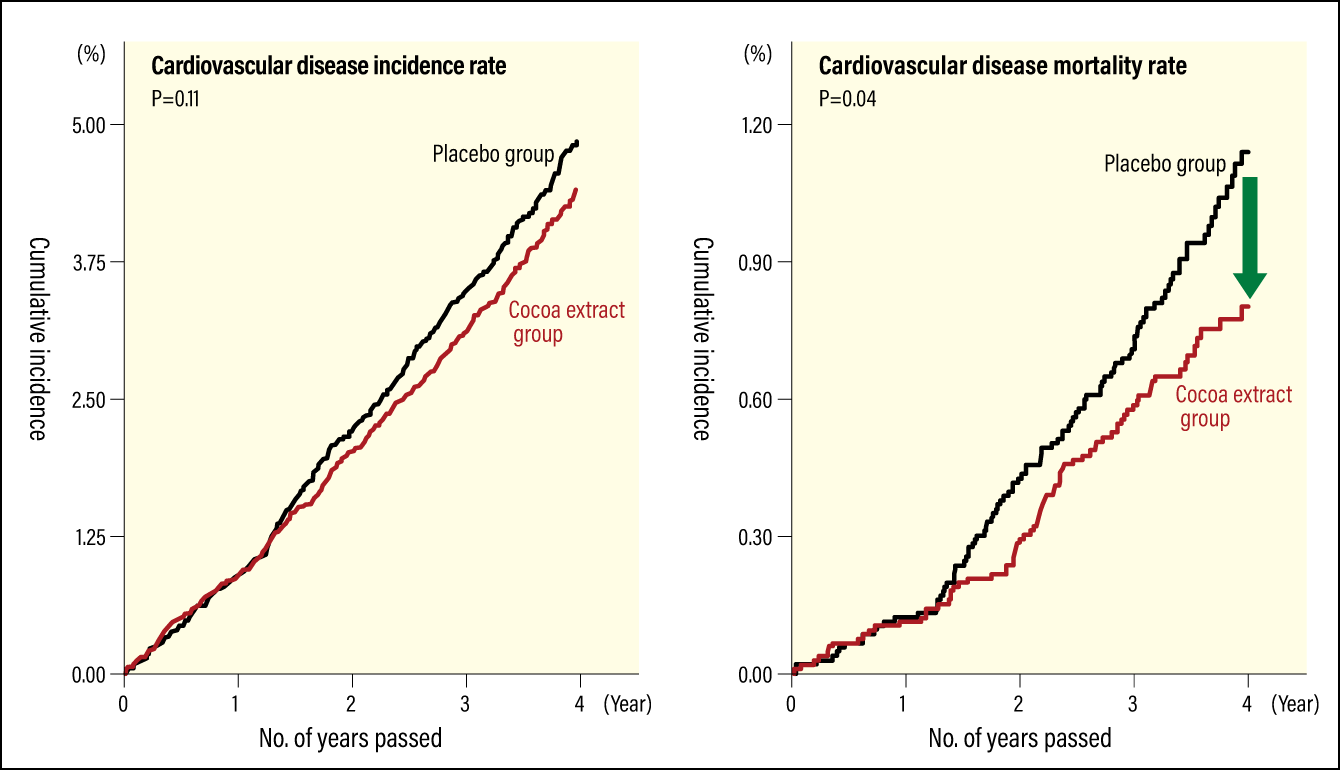 Partly modified from Sesso HD, et al. Am J Clin Nutr, 115: 1490–1500, 2022.
Partly modified from Sesso HD, et al. Am J Clin Nutr, 115: 1490–1500, 2022.
Figure 2. Large-scale intervention trial concerning cardiovascular disease and polyphenol intakeA large-scale intervention trial in the U.S. compared the cardiovascular disease incidence and mortality rates in a group that took a cocoa extract and in a placebo group over a four-year period. The results showed that taking the cocoa extract significantly reduced the mortality rate from cardiovascular disease.
More recently, other studies have been focusing on the potential for selective removal of senescent cells by polyphenols. Thought to be a contributing factor to lifestyle diseases, senescent cells appear as we age, and accumulate in the liver and other organs. The amplification of senescent cells is believed to spread substances that cause inflammation, and human clinical studies are now being conducted into senolysis —— the removal of senescent cells —— with the aid of chemical compounds called senolytics, which selectively eliminate senescent cells. One candidate compound that has emerged is a type of polyphenol called quercetin; I am observing the progress of research in this area with interest.
Unraveling the mechanisms of polyphenols’ action will be essential to the progress of polyphenol research. Shedding light on these mechanisms will likely lead to more effective use of polyphenols in maintaining and promoting health.
Moreover, in my opinion, bringing to light the relationship of polyphenols to the significance of fruit and vegetable intake in our diets will allow us to set daily polyphenol reference intakes and recommended intakes. In order to do so, we will need to compile a database of the polyphenol content of foods, move forward with intervention trials and epidemiological studies, and establish scientific evidence by conducting a comprehensive functional evaluation. I expect that polyphenols will come to be positioned as the seventh nutrient (biofactor), alongside the three major nutrients, vitamins, minerals, and dietary fiber. While polyphenol research faces many challenges that are difficult to resolve, I believe the potential of polyphenols merits further scientific efforts.







